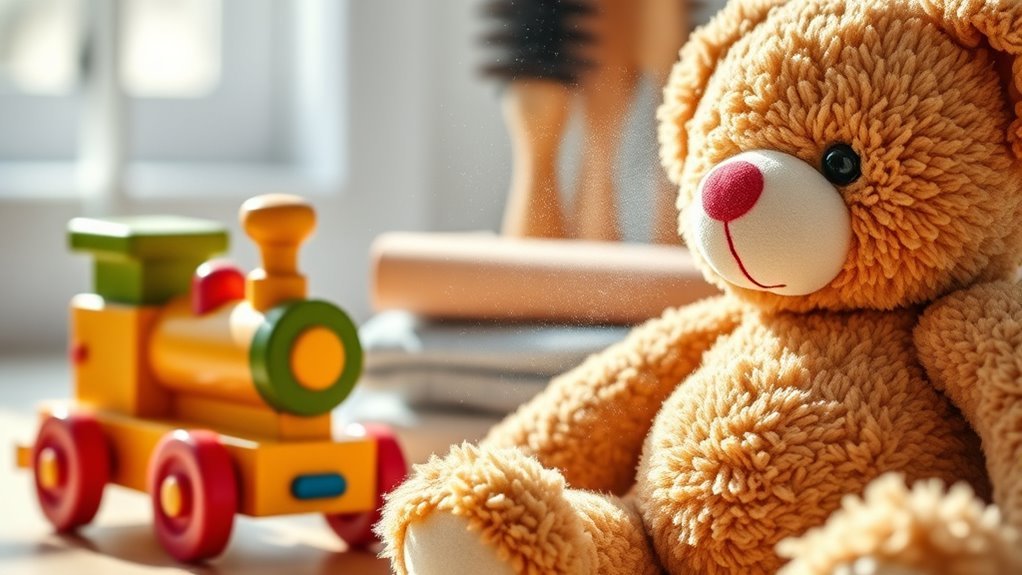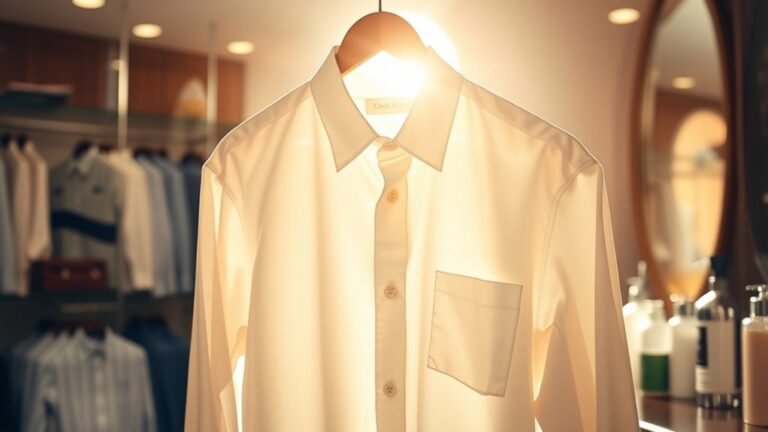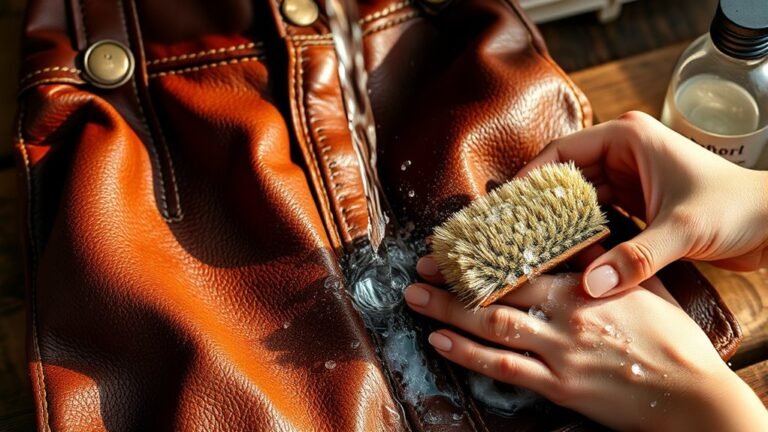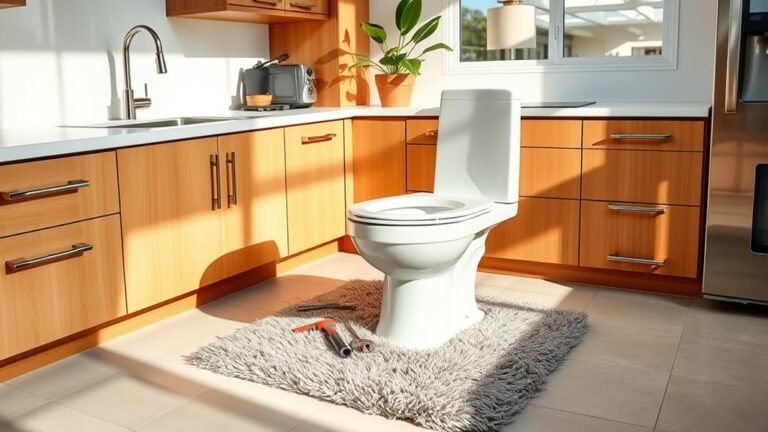How to Make Homemade Toys Cleaner
To make your homemade toys cleaner, choose gentle, non-toxic cleaning materials suited to each toy’s type—mild soap for wood, eco-friendly cleaners for plastics, and careful washing for fabrics. Wipe wooden toys with a damp cloth and dry well to avoid damage. Disinfect recycled materials gently without soaking to preserve textures. Regularly clean high-touch spots and store toys properly to prevent germs. Keep these tips in mind, and you’ll find even better ways to maintain your toys’ cleanliness and safety.
Choosing the Right Cleaning Materials for Different Toy Types

When you’re cleaning homemade toys, choosing the right materials is key because different toys require different care. You want to keep toy safety front and center, especially if they’re made from various materials like wood, fabric, or plastic. Using eco friendly cleaners is a smart move—they’re gentle on both the toys and the environment, letting you maintain freedom from harsh chemicals. For wooden toys, a damp cloth with mild soap works well, avoiding soaking to prevent damage. Plastic toys can handle a bit more scrubbing but still benefit from non-toxic cleaners. Always avoid anything abrasive or chemical-heavy that could wear down or harm the toy’s surface. By selecting appropriate, eco friendly options, you guarantee safe, effective cleaning that respects your desire for a healthy, liberated lifestyle.
Step-by-Step Cleaning Techniques for Fabric Toys
Cleaning fabric toys effectively involves a few simple steps that guarantee they’re fresh without causing damage. First, check the fabric toy care label for specific washing instructions. Next, gently remove surface dirt with a soft brush or cloth. Then, decide whether to hand wash or machine wash based on the toy’s sturdiness.
| Step | Action | Tip |
|---|---|---|
| 1 | Check label | Follow fabric toy care |
| 2 | Surface clean | Use soft brush or cloth |
| 3 | Wash accordingly | Hand wash or gentle cycle |
After washing, air dry the toy completely before use. This method keeps your fabric toys clean, safe, and ready for play without compromising their integrity.
Safe Cleaning Methods for Wooden Homemade Toys

Although wooden homemade toys are durable, you’ll want to avoid harsh chemicals that can damage the finish or seep into the wood. For natural cleaning, start by wiping the toys with a soft cloth dampened in a mixture of mild soap and water. This simple method keeps your wooden toys fresh without compromising their integrity. After cleaning, dry them thoroughly to prevent moisture from warping the wood. For wooden toy care, applying a small amount of natural oil like coconut or beeswax can help maintain the wood’s luster and protect it from cracking. These safe cleaning methods let you keep your handmade toys clean while embracing natural, gentle care that preserves their charm and longevity. You’re free to enjoy your creations without worry.
Disinfecting Recycled Material Toys Without Damage
Since recycled material toys often combine various textures and components, you’ll need to disinfect them carefully to avoid damage. Balancing toy safety with effective cleaning is key when working with these unique creations.
Disinfect recycled toys gently to preserve their unique textures and ensure safe, effective cleaning.
- Use a gentle solution of water and mild soap or vinegar to avoid harsh chemicals that can degrade recycled materials.
- Apply the solution with a soft cloth or sponge, focusing on surface cleaning without soaking the toy, which prevents warping or breakdown.
- Let the toy air dry completely in a well-ventilated area, ensuring moisture doesn’t linger and cause mold or damage.
Tips for Maintaining Cleanliness and Preventing Germ Buildup

When you want to keep toys safe and hygienic, regular maintenance is essential to prevent germs from accumulating. Focus on identifying germ hotspots like handles, buttons, and fabric surfaces where bacteria tend to linger. Clean these areas frequently using gentle disinfectants suitable for your homemade materials. Also, avoid letting toys sit out in the open; instead, use proper toy storage solutions that keep them dry and dust-free. Rotate toys regularly to reduce constant exposure and allow thorough cleaning. Encourage handwashing before and after play to minimize contamination. Finally, inspect toys routinely for damage that can harbor germs, repairing or discarding them as needed. By staying consistent with these simple steps, you’ll maintain a clean, safe environment while enjoying the freedom of homemade fun.
Frequently Asked Questions
How Often Should Homemade Toys Be Cleaned for Optimal Hygiene?
Think of cleaning homemade toys like watering a garden—you wouldn’t skip days, or the plants would suffer. For ideal hygiene, you should stick to a regular cleaning frequency, ideally once a week, to keep germs at bay and meet hygiene standards. This routine lets you enjoy your creations freely, without worries. Remember, a little effort in cleaning keeps your toys safe and your playtime carefree.
Can Homemade Toy Cleaning Solutions Cause Allergies in Children?
Yes, homemade toy cleaning solutions can cause allergy symptoms if they contain harsh chemicals or irritants. To keep your child safe, you’ll want to choose safe ingredients like mild soap, vinegar, or baking soda, which are less likely to trigger allergies. Always test a small area first and watch for any reactions. Remember, freedom comes with responsibility—using gentle, natural cleaners helps protect your little one without limiting your creativity.
What’s the Best Way to Store Homemade Toys After Cleaning?
When storing your homemade toys after cleaning, you want to keep things simple and efficient. Use clear bins or labeled containers to make toy storage easy and accessible. Organize by type or size to save time and avoid clutter. You can even repurpose baskets or drawers for a more flexible setup. Remember, freedom means a clutter-free space where toys are ready whenever creativity strikes—so keep it neat, but easy to change!
Are There Any Homemade Toy Materials That Should Never Be Cleaned?
Some soft, sensitive surfaces should stay spotless by skipping scrubbing. When it comes to natural materials like untreated wood, wool, or delicate fabrics, harsh cleaning methods can damage their charm. You’ll want to embrace gentle approaches—like spot cleaning or air drying—to preserve their natural beauty. So, if you cherish freedom from fuss, avoid aggressive washing that might warp or wear out these treasured homemade toys.
How to Handle Mold Growth on Homemade Toys Safely?
If you spot mold on homemade toys, you’ve got to act quick for safe cleaning. First, wear gloves and a mask to protect yourself. Gently scrub the mold with a mix of white vinegar and water, then let the toy air dry completely. To keep mold prevention in check, store toys in dry, well-ventilated spaces and avoid damp conditions. This way, your toys stay fresh and safe for endless play!






